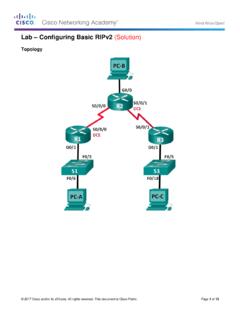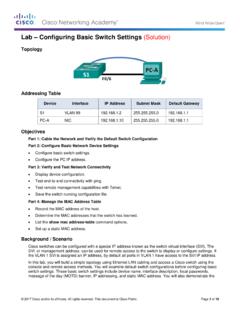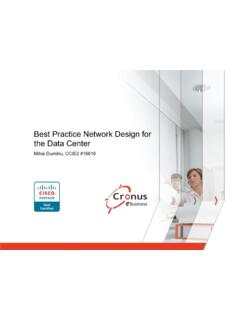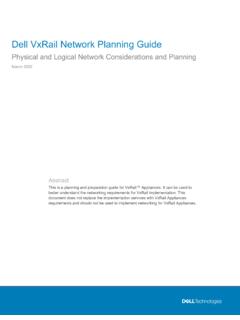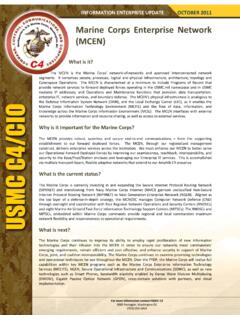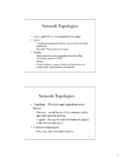Transcription of Lab – Configuring IPv4 Static and Default Routes (Solution ...
1 2017 Cisco and/or its affiliates. All rights reserved. This document is Cisco Public. Page 1 of 16 Lab Configuring IPv4 Static and Default Routes (Solution) topology Addressing Table Device Interface IP Address Subnet Mask Default Gateway R1 G0/1 N/A S0/0/1 N/A R3 G0/1 N/A S0/0/0 (DCE) N/A Lo0 N/A Lo1 N/A PC-A NIC PC-C NIC Objectives Part 1: Set Up the topology and Initialize Devices Lab Configuring IPv4 Static and Default Routes 2017 Cisco and/or its affiliates. All rights reserved. This document is Cisco Public. Page 2 of 16 Part 2: Configure Basic Device Settings and Verify Connectivity Part 3: Configure Static Routes Configure a recursive Static route.
2 Configure a directly connected Static route. Configure and remove Static Routes . Part 4: Configure and Verify a Default Route Background / Scenario A router uses a routing table to determine where to send packets. The routing table contains a set of Routes that describe which gateway or interface the router uses to reach a specified network . Initially, the routing table contains only directly connected networks. To communicate with distant networks, Routes must be specified and added to the routing table. In this lab, you will manually configure a Static route to a specified distant network based on a next-hop IP address or exit interface.
3 You will also configure a Static Default route. A Default route is a type of Static route that specifies a gateway to use when the routing table does not contain a path for the destination network . Note: This lab provides minimal assistance with the actual commands necessary to configure Static routing. However, the required commands are provided in Appendix A. Test your knowledge by trying to configure the devices without referring to the appendix. Note: The routers used with CCNA hands-on labs are Cisco 1941 Integrated Services Routers (ISRs) with Cisco IOS Release (4)M3 (universalk9 image). The switches used are Cisco Catalyst 2960s with Cisco IOS Release (2) (lanbasek9 image).
4 Other routers, switches, and Cisco IOS versions can be used. Depending on the model and Cisco IOS version, the commands available and output produced might vary from what is shown in the labs. Refer to the Router Interface Summary Table at the end of this lab for the correct interface identifiers. Note: Make sure that the routers and switches have been erased and have no startup configurations. If you are unsure, contact your instructor. Required Resources 2 Routers (Cisco 1941 with Cisco IOS Release (4)M3 universal image or comparable) 2 Switches (Cisco 2960 with Cisco IOS Release (2) lanbasek9 image or comparable) 2 PCs (Windows 7, Vista, or XP with terminal emulation program, such as Tera Term) Console cables to configure the Cisco IOS devices via the console ports Ethernet and serial cables as shown in the topology Part 1: Set Up the topology and Initialize Devices Step 1: Cable the network as shown in the topology .
5 Step 2: Initialize and reload the router and switch. Part 2: Configure Basic Device Settings and Verify Connectivity In Part 2, you will configure basic settings, such as the interface IP addresses, device access, and passwords. You will verify LAN connectivity and identify Routes listed in the routing tables for R1 and R3. Lab Configuring IPv4 Static and Default Routes 2017 Cisco and/or its affiliates. All rights reserved. This document is Cisco Public. Page 3 of 16 Step 1: Configure the PC interfaces. Step 2: Configure basic settings on the routers. a. Configure device names, as shown in the topology and Addressing Table.
6 B. Disable DNS lookup. c. Assign class as the enable password and assign cisco as the console and vty password. d. Save the running configuration to the startup configuration file. Step 3: Configure IP settings on the routers. a. Configure the R1 and R3 interfaces with IP addresses according to the Addressing Table. b. The S0/0/0 connection is the DCE connection and requires the clock rate command. The R3 S0/0/0 configuration is displayed below. R3(config)# interface s0/0/0 R3(config-if)# ip address R3(config-if)# clock rate 128000 R3(config-if)# no shutdown Step 4: Verify connectivity of the LANs.
7 A. Test connectivity by pinging from each PC to the Default gateway that has been configured for that host. From PC-A, is it possible to ping the Default gateway? _____ Yes From PC-C, is it possible to ping the Default gateway? _____ Yes b. Test connectivity by pinging between the directly connected routers. From R1, is it possible to ping the S0/0/0 interface of R3? _____ Yes If the answer is no to any of these questions, troubleshoot the configurations and correct the error. c. Test connectivity between devices that are not directly connected. From PC-A, is it possible to ping PC-C? _____ No From PC-A, is it possible to ping Lo0?
8 _____ No From PC-A, is it possible to ping Lo1? _____ No Were these pings successful? Why or why not? _____ _____ No, the router does not contain Routes to the distant networks. Note: It may be necessary to disable the PC firewall to ping between PCs. Step 5: Gather information. a. Check the status of the interfaces on R1 with the show ip interface brief command. R1# show ip interface brief Interface IP-Address OK? Method Status Protocol Embedded-Service-Engine0/0 unassigned YES unset administratively down down Lab Configuring IPv4 Static and Default Routes 2017 Cisco and/or its affiliates.
9 All rights reserved. This document is Cisco Public. Page 4 of 16 GigabitEthernet0/0 unassigned YES unset administratively down down GigabitEthernet0/1 YES manual up up Serial0/0/0 unassigned YES unset administratively down down Serial0/0/1 YES manual up up How many interfaces are activated on R1? _____ Two b. Check the status of the interfaces on R3. R3# show ip interface brief Interface IP-Address OK? Method Status Protocol Embedded-Service-Engine0/0 unassigned YES unset administratively down down GigabitEthernet0/0 unassigned YES unset administratively down down GigabitEthernet0/1 YES manual up up Serial0/0/0 YES manual up up Serial0/0/1 unassigned YES unset administratively down down Loopback0 YES manual up up Loopback1 YES manual up up How many interfaces are
10 Activated on R3? _____ Four c. View the routing table information for R1 using the show ip route command. R1# show ip route Codes: L - local, C - connected, S - Static , R - RIP, M - mobile, B - BGP D - EIGRP, EX - EIGRP external, O - OSPF, IA - OSPF inter area N1 - OSPF NSSA external type 1, N2 - OSPF NSSA external type 2 E1 - OSPF external type 1, E2 - OSPF external type 2 i - IS-IS, su - IS-IS summary, L1 - IS-IS level-1, L2 - IS-IS level-2 ia - IS-IS inter area, * - candidate Default , U - per-user Static route o - ODR, P - periodic downloaded Static route, H - NHRP, l - LISP + - replicated route, % - next hop override Gateway of last resort is not set is variably subnetted.
